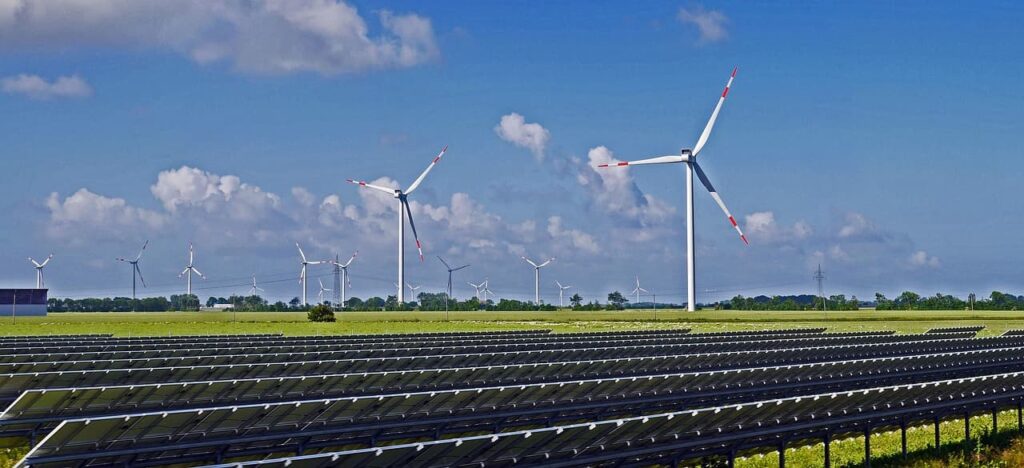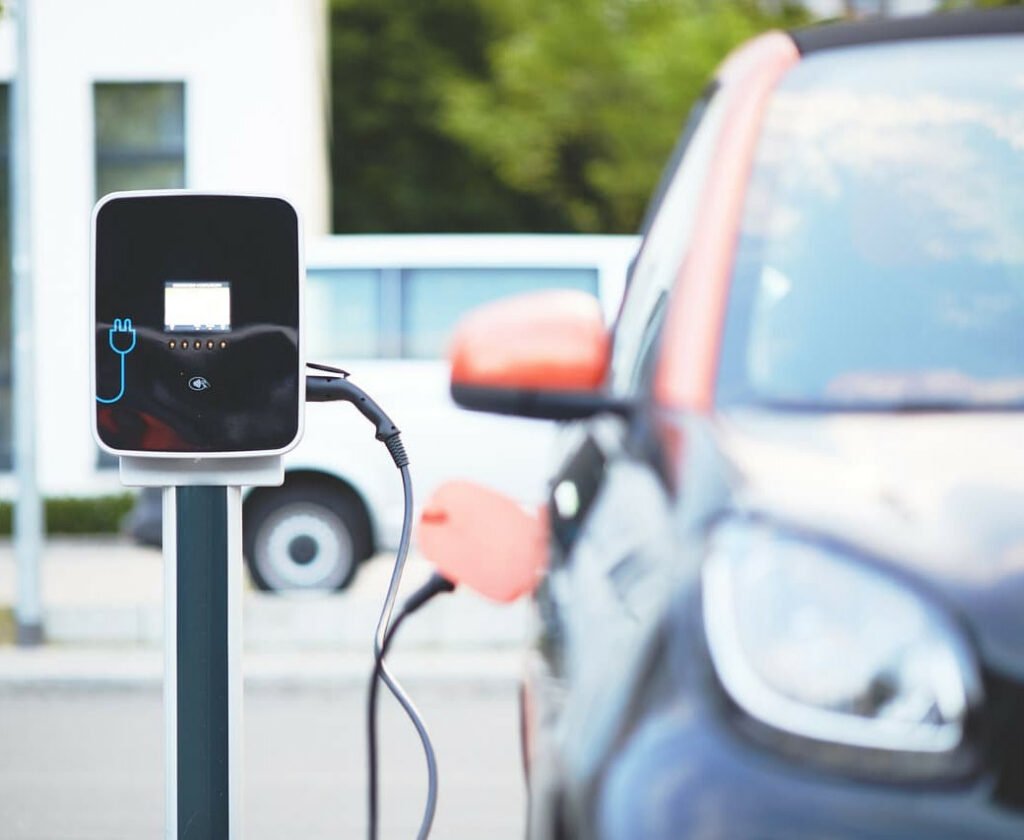The introduction of the Charging Pillar Act, more precisely: “Building Electric Mobility Infrastructure Act” (GEIG), in 2021 in Germany marked a significant step towards the promotion of electric mobility in the country. The law obliges companies to provide charging facilities for electric vehicles at their locations. This has far-reaching consequences for all areas powered by electricity:
From 2025, however, most companies will not only need charging stations, but at the same time an intelligent power control system that also includes lighting, for example – because in order to be able to operate the charging stations economically and sensibly, there is no way around a networked control system for all areas that use electricity.
Why do companies need intelligent power control from 2025?
The “Building Electric Mobility Infrastructure Act” (GEIG) is often referred to as the “charging station law”. However, the law is much more. It transposes the “EU Energy Performance of Buildings Directive” into national law and came into force on 25 March 2021.
In the public perception, the law is mainly about the obligation to install charging points. For example, it stipulates that companies that offer vehicle parking spaces in or on their buildings must equip a defined part of them with charging infrastructure from 2025:
Different requirements apply for residential and non-residential space (commercial buildings) as well as for new and existing buildings. In the case of existing buildings, a distinction is made between those that undergo major renovation and those that remain unchanged. Important: Even for non-residential space without renovation requirements, there are specifications for the installation of charging infrastructures!
Even for commercial buildings not in need of renovation, there will be an obligation to install charging infrastructure from 2025 onwards.
Which and how many charging facilities must be offered is graded according to building type and condition:
| Type of building | Number of parking spaces in the building or adjoining | Required charging infrastructure. |
| Residential building New building |
> 5 | wiring infrastructure at each parking space |
| Residential building “major renovation” | > 10 | wiring infrastructure at each parking space |
| Residential building Existing buildings |
No regulation | No regulation |
| Non-residential buildings New construction | > 6 | At least every 3rd parking space wiring infrastructure and at least 1 parking space charging infrastructure |
| Non-residential buildings “major renovation” | > 10 | At least every 5th parking space wiring infrastructure and at least 1 parking space charging infrastructure |
| Non-residetial buldings Existing buildings | > 20 | At least 1 charging point. In the case of several affected buildings in a spatial context, also possible as a “neighbourhood solution”. |
So far, so challenging. But is it enough to simply install charging points?
In fact, there is much more to the topic!
In the short term, without efficient management of charging, several problems
- First and foremost, there can be problems with power grid overloads.
- Second: It can be expensive! The load tariffs of electricity consumers with more than 100,000 kWh per year are based on calculated and provided services as well as the peak loads that are measured at some point in the year. Every additional load peak, e.g. through charging stations, leads to considerable cost increases in the monthly basic costs per kW provided!
- And last: The charging pole infrastructure simply does not work.
In the near future, therefore, the entire way in which we obtain and pay for electricity will fundamentally change from a broader perspective. No company will be able to get by without effective load management.
Variable electricity prices: When electricity prices differ hourly
As the electricity market continues to develop with the increasingly dominant influence of renewable energies, electricity prices are constantly changing due to the dependence of generation volumes on time of day and weather. And the prices for electricity are correspondingly volatile – all the way to negative prices when wind turbines already have to be shut down because of strong sunshine and yet there is “too much” electricity flowing in the grid.
Added to this is the spatially uneven distribution of electricity generation in Germany. In combination, there are already energy contracts with variable electricity prices linked to the prices on the electricity exchange: To put it bluntly, electricity is cheap in sunny weather and at lunchtime, but hardly affordable in times of low wind or dark nights.

Intelligent load control is the only sensible “way out”
This is where the importance of intelligent electricity control comes into play. This technology enables companies to optimise their electricity use: If the sun is shining, the electricity is particularly cheap – then the charging stations “hit the gas” and provide their full charging power. If, on the other hand, it is cool and cloudy, wind is scarce, the lights are on in the entire region, the heat pumps are humming and the electricity price shoots up accordingly – then the intelligent technology regulates the capacity of the charging columns down.

At the same time, it is important to choose the right charging station. Not every charging station is suitable for integration via a manufacturer-independent building management system such as KNX. To avoid double expenditure, this should also be taken into account directly.
However, the charging facilities are not the only area of consumption where clever control technology can save electricity – and electricity costs.
Lighting in particular also plays a decisive role in the energy efficiency of companies. That is why intelligent lighting systems help to optimise energy consumption.
The role of lighting in intelligent power control
Lighting systems are often one of the largest energy consumers in buildings, e.g. in retail and administration. The integration of intelligent lighting systems into the overall strategy of smart electricity control can therefore enable significant savings or simply provide the necessary “playing field” to be able to allocate electricity to other areas that are less flexible in terms of consumption.
Lighting is particularly suitable for saving electricity at peak consumption times or in high-price phases – or in general.
Some examples of how intelligent lighting control can contribute to this:
- Presence and motion sensors: Intelligent lighting systems can detect when rooms are not being used and automatically switch off the lighting. In corridors, the light can run along with people passing by or “go ahead” via motion sensors and dim down again directly behind the people. This reduces energy consumption considerably.
- Use of daylight: Lighting can be controlled according to the intensity of daylight, reducing the use of artificial light.
- Timers and schedules: Lighting systems can be programmed so that they are only switched on when they are needed, for example during working hours. And the light intensity can also be varied to suit the time of day and task area, which can even have a positive effect on the psyche and work performance.
- Remote control: The possibility to control lighting remotely enables companies to further increase energy efficiency. However, useless gimmicks should be avoided.
Conclusion
The Charging Station Act forces companies to take a close look at electromobility (or generally at the way they want to use electricity in the future)! Intelligent power control will be indispensable from 2025 onwards to efficiently manage the growing energy demand.
In this context, smart lighting control plays an important role in reducing energy consumption and improving the energy efficiency of companies. Companies that adopt smart technologies early on can not only meet regulatory requirements, but also benefit from cost savings and more sustainable operations in the long run.
Image credits Header image: Markus Distelrath via Pixabay



